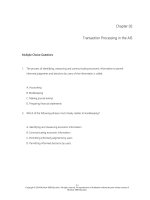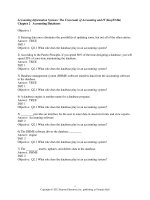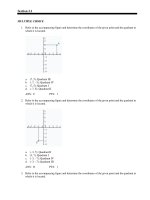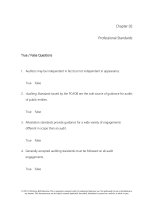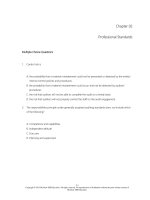Research methods and statistics for public and nonprofit administrators 1st edition nishishiba test bank
Bạn đang xem bản rút gọn của tài liệu. Xem và tải ngay bản đầy đủ của tài liệu tại đây (425.81 KB, 10 trang )
Research Methods and Statistics for Public and Nonprofit Administrators
Nishishiba, Jones and Kraner
Instructor Resource
Chapter 2: Research Alignment
Test Bank
Multiple Choice
1. A thorough _____________________ is useful to understand how other researchers designed
and executed their studies.
a. research question
b. data collection
c. research design
*d. literature review
2. At what point is it important to consider how data will be analyzed?
*a. At the beginning of your research
b. After you have collected the data
c. After you have selected your study participants
d. After you have identified your research design
3. In Emily’s case, the people who will receive the trainings are considered to be members of the
_________________.
a. control group
*b. experimental group
c. expected group
d. non-treatment group
Research Methods and Statistics for Public and Nonprofit Administrators
Nishishiba, Jones and Kraner
Instructor Resource
4. If your research question asks about people’s experience of the first class of the year, then
your ________________ is the individual.
*a. unit of analysis
b. control group
c. population
d. experimental group
5. __________________ data is data that is represented numerically.
a. Scientific
b. Qualified
c. Qualitative
*d. Quantitative
6. A __________________ is a group of study participants who do not receive the intervention
or treatment.
a. population
b. experimental group
*c. control group
d. non-experimental group
7. One aspect of _________________ is discussing the implications of your research results.
*a. reporting
b. data analysis
c. data collection
d. a literature review
Research Methods and Statistics for Public and Nonprofit Administrators
Nishishiba, Jones and Kraner
Instructor Resource
8. An experimental design has an ________________ and a _________________.
a. expected group; control group
b. experimental group; non-experimental group
c. expected group; non-expected group
*d. experimental group; control group
9. The first step in the research process is __________________.
a. performing a literature review
*b. identifying the research objective
c. establishing a research question
d. identifying how you will collect data
10. The seven steps of the research process are considered an ______________ process.
a. linear
b. sequential
c. random
*d. iterative
11. ____________________ is the step in the research process in which you evaluate your data
in an attempt to answer your research question.
*a. Data analysis
b. Data collection
c. Literature review
d. Determining the research design
Research Methods and Statistics for Public and Nonprofit Administrators
Nishishiba, Jones and Kraner
Instructor Resource
12. Determining from whom or what you are collecting data from is known as the
____________________.
a. data collection
*b. sample selection
c. unit of selection
d. data selection
13. In all research, the research objective is designed to address a(n) ___________________.
*a. problem
b. research question
c. particular data set
d. experimental design
14. Emily considers conducting a _______________ assessment so that she can compare that
data to data collected after the diversity training.
a. mid-training
*b. baseline
c. single factor
d. confounding factor
15. A ______________ is the group of individuals or entities you select for the study.
a. population
b. unit of analysis
Research Methods and Statistics for Public and Nonprofit Administrators
Nishishiba, Jones and Kraner
Instructor Resource
*c. sample
d. experimental group
16. In order to make the groups roughly equivalent, Emily will assign the participants to the
groups ____________________.
a. by department
b. based on gender
c. by age
*d. randomly
17. After establishing a research objective, the researcher should then rephrase the objective into
a __________________.
a. research design
b. research problem
*c. research question
d. research focus
18. For Emily’s research question, “does the training decrease workplace tension?” what is her
unit of analysis?
*a. the workplace
b. the individual
c. the work units
d. the departments
Research Methods and Statistics for Public and Nonprofit Administrators
Nishishiba, Jones and Kraner
Instructor Resource
19. Prior to gathering data, the researcher should identify the _______________ and
_________________.
*a. research objective; research question
b. research results; study participants
c. research objective; study conclusions
d. research question; research results
20. Surveys, interviews, and observations are all examples of _________________.
a. research designs
*b. data collection methods
c. background data analysis
d. data analysis
21. When data is collected from all participants prior to an intervention as well as postintervention, it is a _________________ design.
a. case study
b. cross sectional
*c. before-and-after
d. observational
22. A survey is an example of a ___________________ instrument.
a. sample selection
b. research design
*c. data collection
d. before-and-after design
Research Methods and Statistics for Public and Nonprofit Administrators
Nishishiba, Jones and Kraner
Instructor Resource
23. The final step in the research process is to __________________.
*a. report the results
b. analyze the data
c. interpret your results
d. collect the data
24. Data collected in the form of narrative or statements is typically considered what type of
data?
a. Quantitative
*b. Qualitative
c. Verbal
d. Non-experimental
25. ____________________ can occur when events external to your research impact your
results.
*a. Confounding factors
b. Controlling factors
c. Mitigating factors
d. Peripheral factors
True/False
26. With any research objective, there is only one corresponding research question.
a. True
*b. False
Research Methods and Statistics for Public and Nonprofit Administrators
Nishishiba, Jones and Kraner
Instructor Resource
27. A literature review will likely be performed throughout the research process, not just at the
beginning.
*a. True
b. False
28. In all research designs, the ethical implications should be considered throughout the process.
*a. True
b. False
29. Emily is planning to deliver the training in phases, where some employees go through the
training while other employees have not, which means she will not have a control group.
a. True
*b. False
30. Clarifying both the research objective and question makes identifying what information
needs to be collected easier.
*a. True
b. False
31. If the research objective is to document a change in cultural competency and you only
measure the employee demographics, your research is considered aligned.
a. True
*b. False
Research Methods and Statistics for Public and Nonprofit Administrators
Nishishiba, Jones and Kraner
Instructor Resource
32. Research results may be confusing or unconvincing if the components of the research are
misaligned.
*a. True
b. False
33. When performing research, it is not acceptable to utilize existing sources of data.
a. True
*b. False
34. In research, you should either have a research objective or a research question, but not both.
a. True
*b. False
35. An ethical consideration in the research process is making sure study subjects are fully
informed of the study purpose and expectations.
*a. True
b. False
Essay
36. Identify and briefly describe each of the seven components of research.
*a. varies
37. Why is it important for a researcher to conduct a thorough literature review throughout the
research process?
Research Methods and Statistics for Public and Nonprofit Administrators
Nishishiba, Jones and Kraner
Instructor Resource
*a. varies
38. Using Emily’s case as an example, discuss the importance of alignment in research and the
possible complications of misaligned research.
*a. Varies



